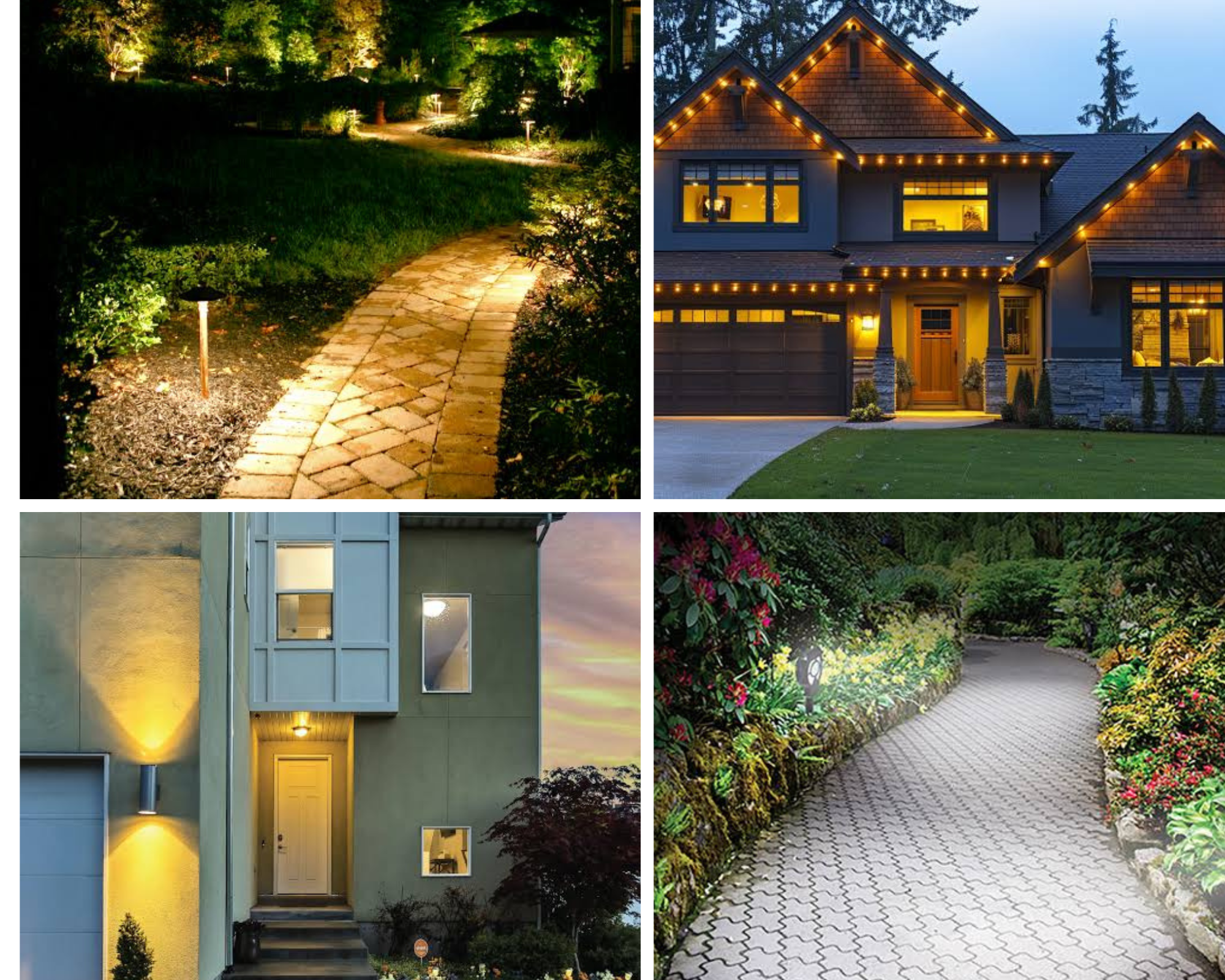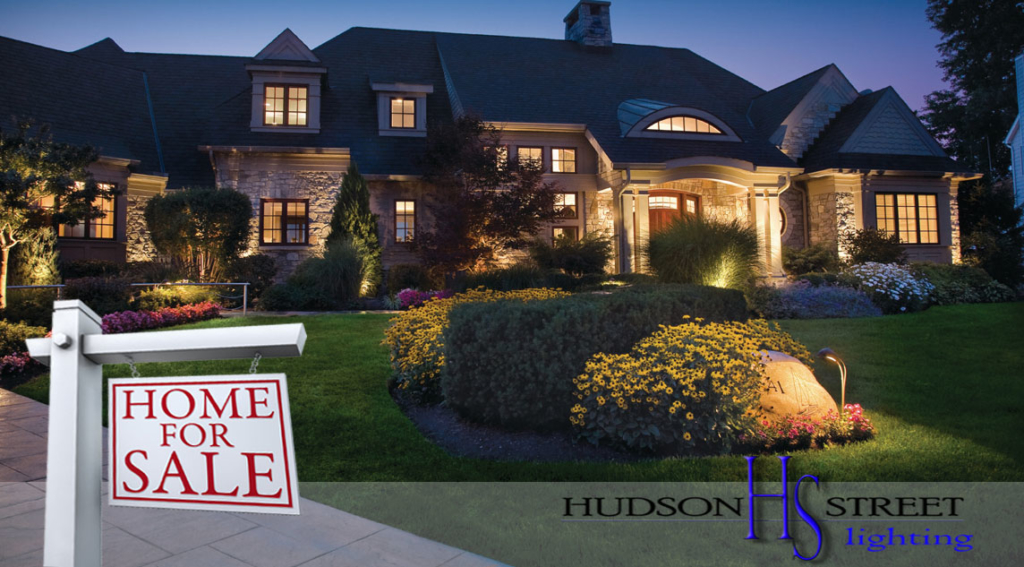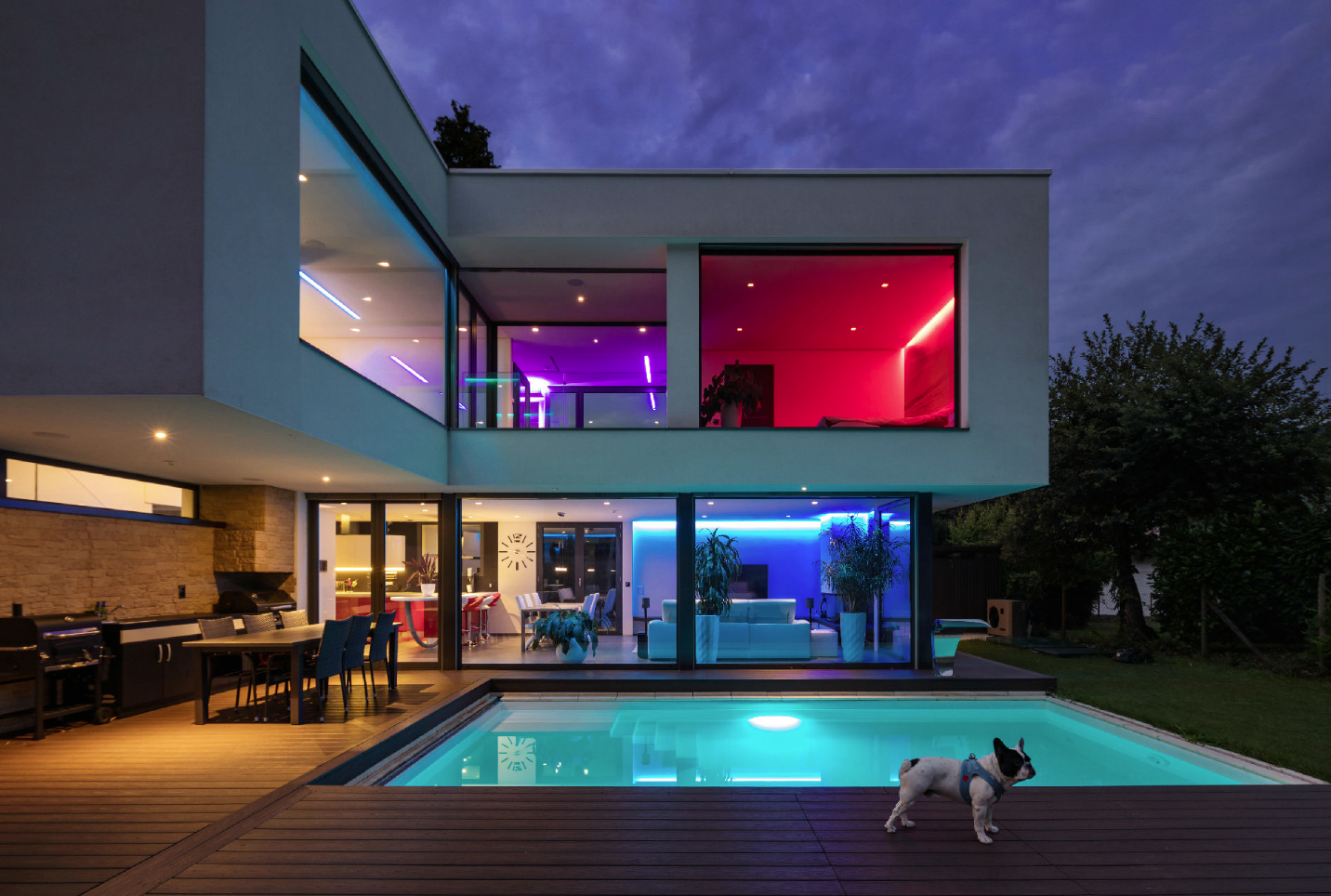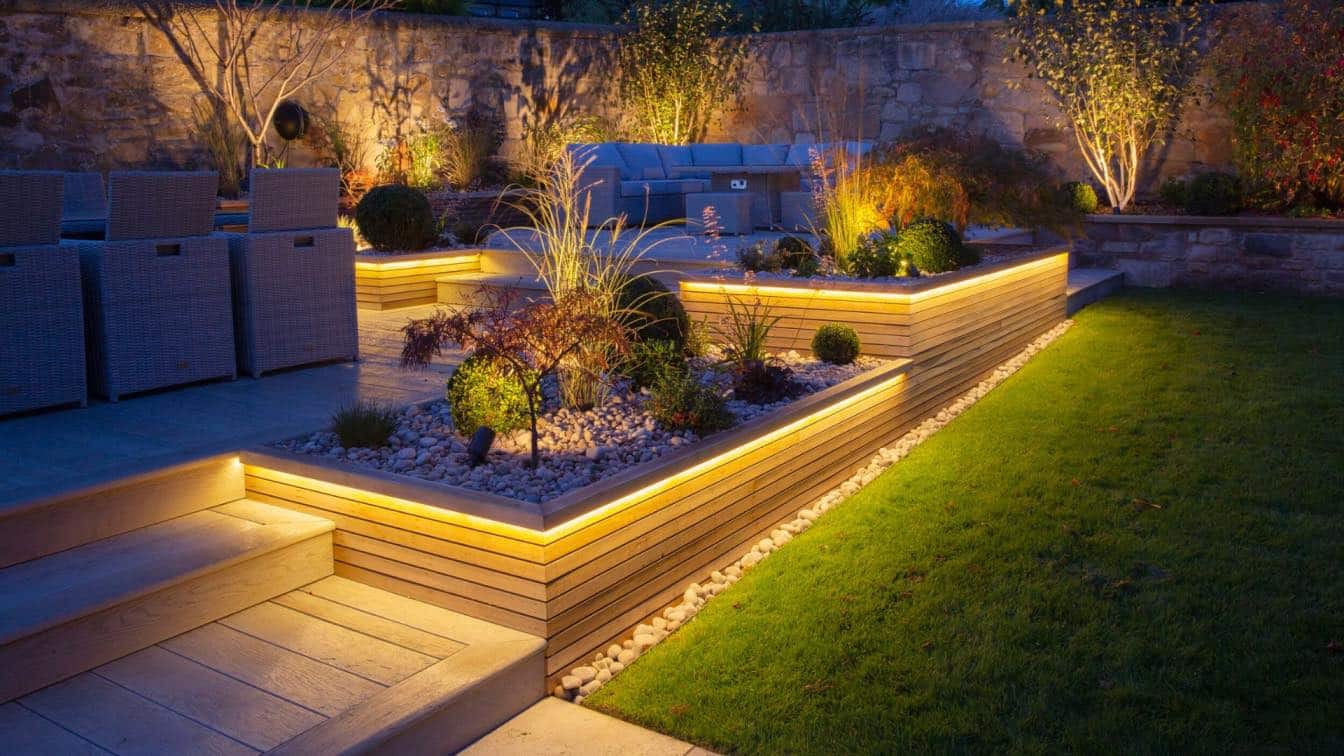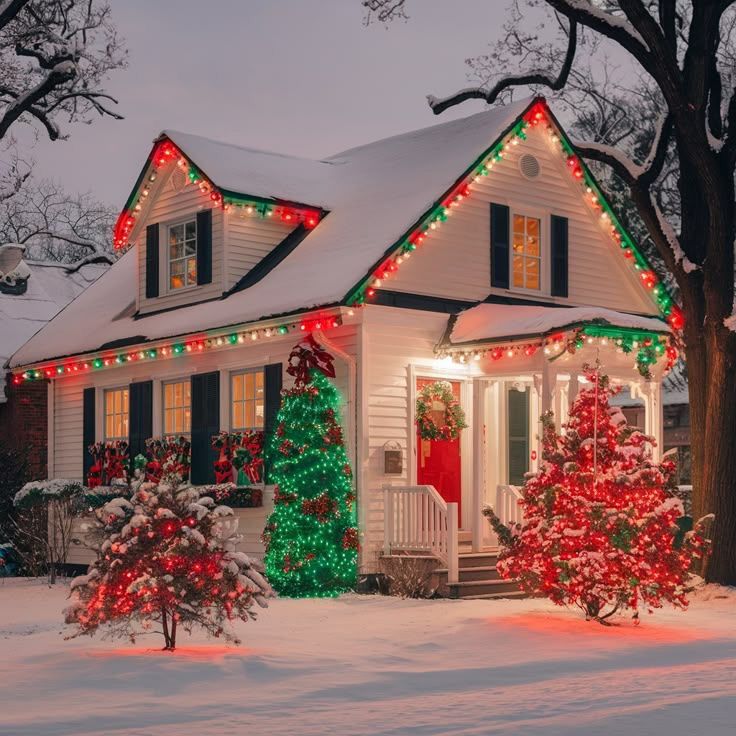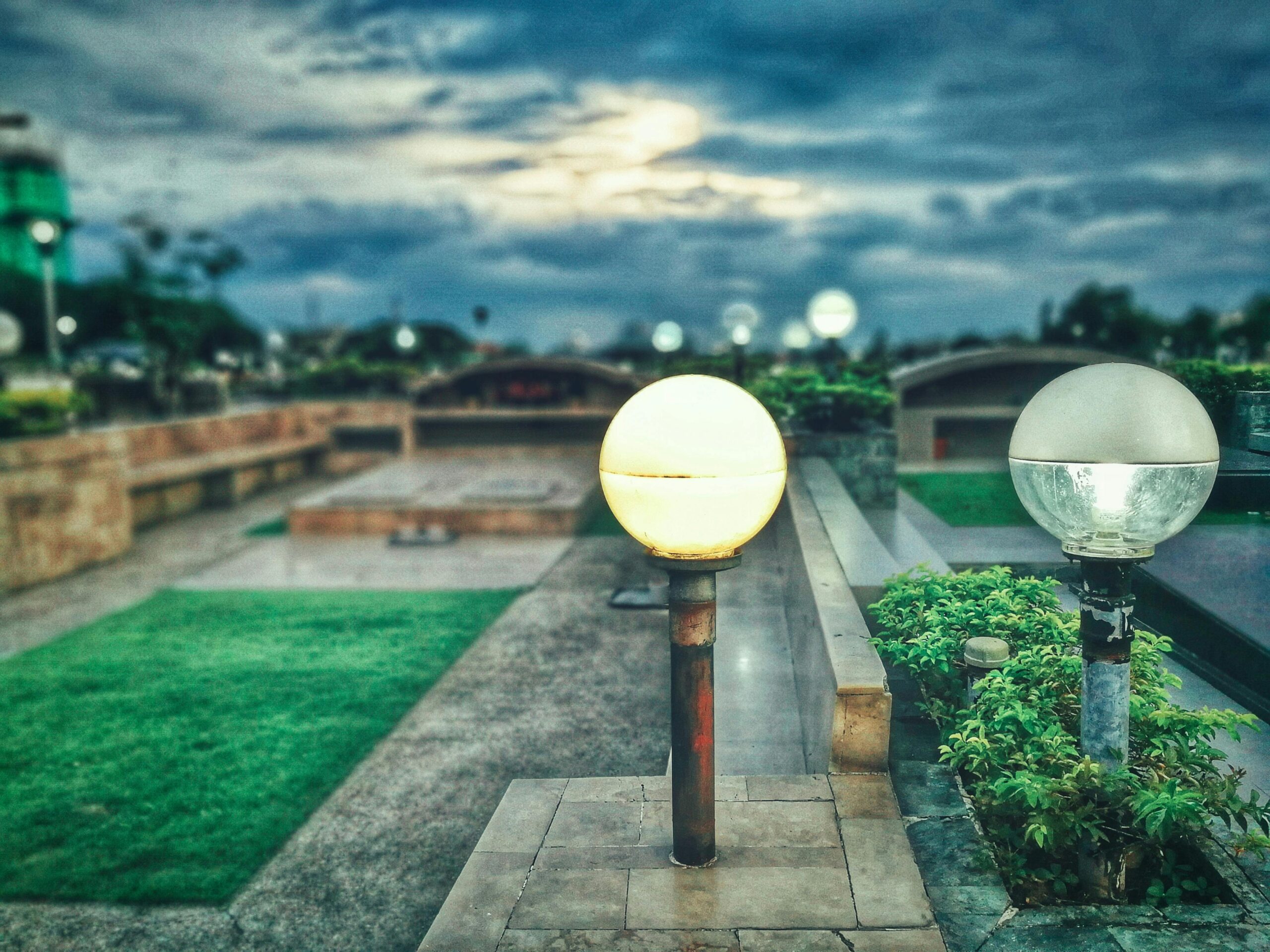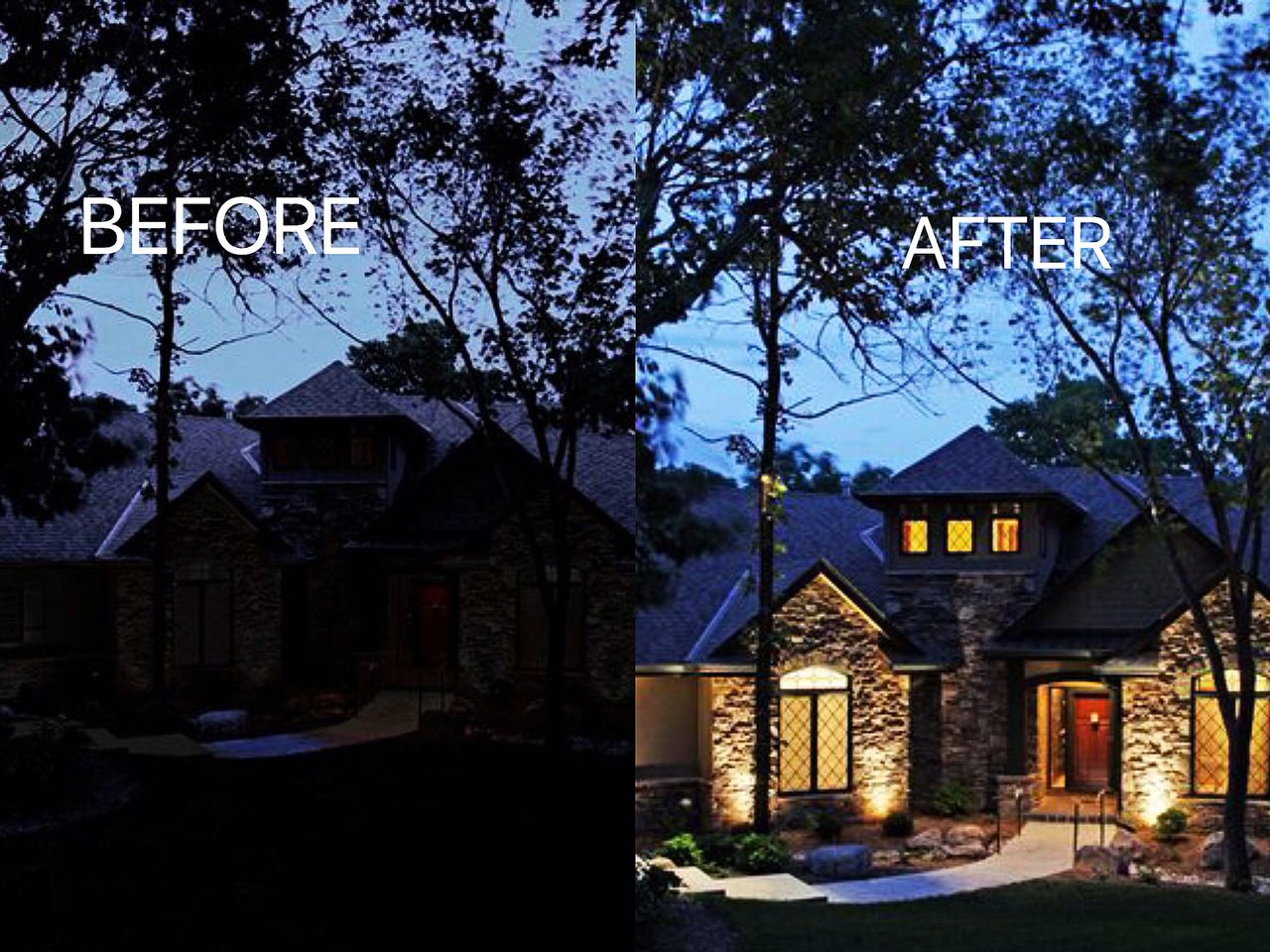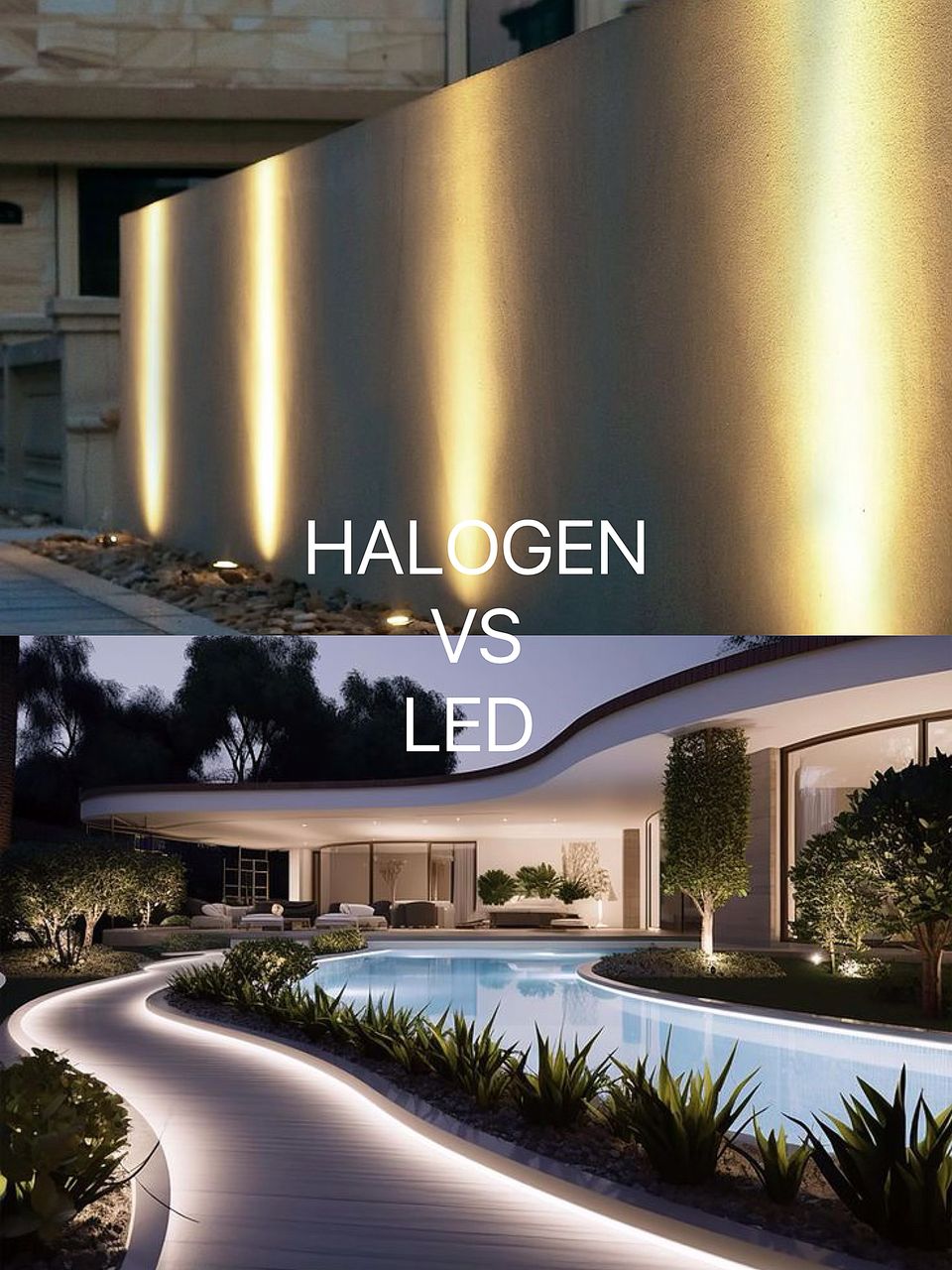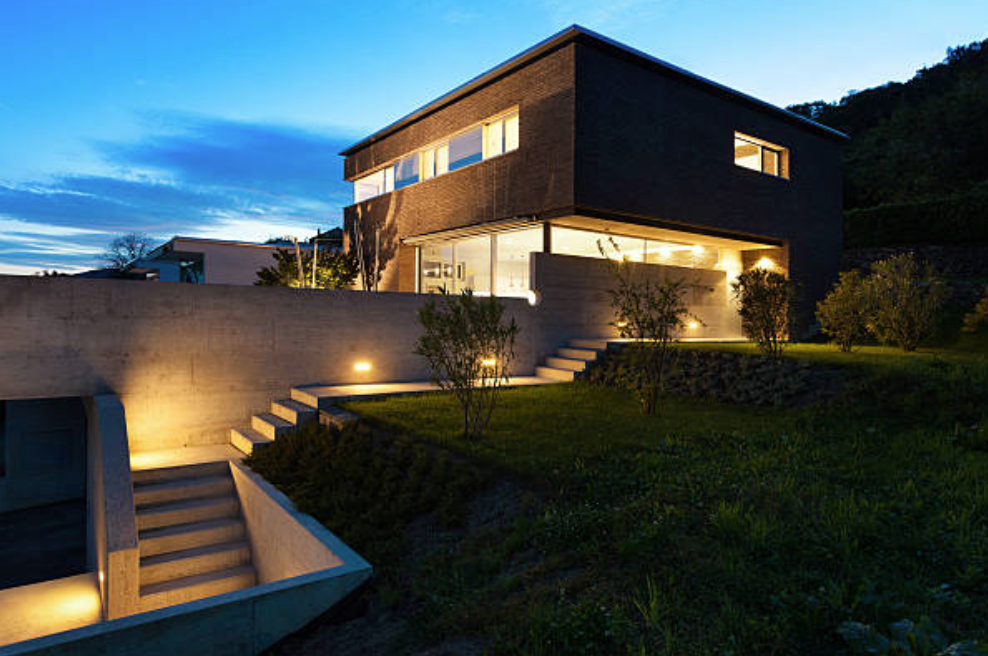Outdoor lighting in Austin isn’t just about aesthetics, it’s about durability, efficiency, and performance under extreme conditions. With temperatures that scorch in the summer and storms that roll through unpredictably, choosing the right lighting system can save you more than just energy. It can save you time, hassle, and money.
When it comes to outdoor lighting in Texas, homeowners often ask the same question: Should I go with LED or halogen fixtures? The answer isn’t just about brightness or cost, it’s about the pros and cons of LED and halogen lighting systems, with a Texas-sized focus on performance in our unique climate. Whether you’re a homeowner in Austin or anywhere in the Lone Star State, this article will help illuminate the smarter choice.
This comprehensive guide compares LED vs Halogen outdoor lighting systems, highlighting the advantages, disadvantages and best use cases for each so you can make an informed choice for your home. But, let’s begin with the basics, shall we?
Why Texas Heat Demands Smarter Lighting
If you live in Texas, you know summer heat is no joke. With average highs often pushing triple digits, your lighting system needs to handle extreme thermal conditions. LEDs are built for this. Unlike halogen bulbs that run hot and often overheat, LEDs stay cool and stable, even when ambient temps rise.
LED vs Halogen: A Quick Overview
What Are LED Lights?
LEDs are solid-state lights that produce illumination through a process called electroluminescence. This means, they convert electricity into light using a semiconductor. Unlike traditional bulbs, they contain no filaments and produce very little heat. They’re known for being energy-efficient, long-lasting, and versatile.
What Are Halogen Lights?
Halogen bulbs are a type of incandescent light that use halogen gas to increase light output and efficiency. They’ve been used in residential and commercial outdoor lighting for decades. They are known for their warm light and intensity.
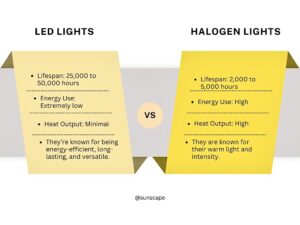
Comparing Performance in the Texas Climate
-
Heat Resistance and Durability
In Texas summers, outdoor temperatures regularly hit triple digits. LEDs perform better in extreme heat, thanks to their solid-state design and low heat emission. Halogens, on the other hand, already run hot—making them vulnerable to burnout or overheating.
-
Moisture and Weatherproofing
Texas is also prone to unexpected rains and high humidity. LED fixtures often come with superior waterproofing and corrosion-resistant housings, while many halogen systems require extra maintenance to stay weatherproof.
Read More: Weatherproof Lighting for Texas Homes: How to Choose Fixtures That Last in Austin’s Climate

Here’s how they compare:
LEDs consume up to 80% less electricity than halogen bulbs. This means significant savings on your energy bill, especially if you’re lighting up a large yard or have automated systems. While halogens may be cheaper upfront, they require frequent replacements and draw more power, making them more expensive long-term.
Explore how smart LED systems can further reduce energy use.
Light Quality and Aesthetic Appeal
LEDs come in various color temperatures, from warm white (2700K) to cool white (5000K+), allowing homeowners to customize their landscape ambiance. Halogens, while often praised for their natural warm glow, lack this flexibility.
And when it comes to brightness and beam control, modern LED landscape lighting offers more directional control and adjustable brightness levels, perfect for spotlighting, path lights, and accent lighting design.
See more ideas on where to place lights in your yard: The Complete Guide to Outdoor Lighting Design for Texas Yards.
Maintenance, Safety and Replacement
LED = Low Maintenance
LEDs are low maintenance and don’t get as hot, reducing fire risk—especially important in drought-prone Texas areas. Most quality LED systems can run for years without replacement. They’re often backed by warranties and require little to no intervention once installed.
Halogen = High Maintenance
Halogens, with their higher heat and shorter lifespan, require more frequent bulb changes and pose more safety concerns. Burned-out halogen bulbs are common. The heat also wears down fixtures and wiring faster, leading to more frequent servicing.
Related Read: 20 Signs You Need an Outdoor Lighting Upgrade | Boost Home Security Today
The Environmental Impact of LED vs Halogen Outdoor Lighting
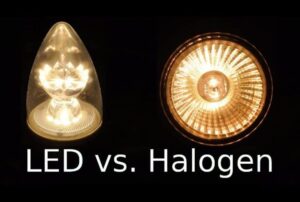
When considering the best outdoor lighting for your home, energy savings and brightness aren’t the only factors worth evaluating. Increasingly, homeowners in Texas and beyond are thinking long-term—asking not just how lights perform, but how they impact the planet over their entire lifecycle. When it comes to manufacturing, halogen lights are a modified version of incandescent bulbs. They’re relatively simple to produce, requiring fewer materials and a smaller carbon footprint at the manufacturing stage. However, that early advantage quickly fades. While, LED lights have a more complex structure. They require circuit boards, semiconductors, and rare earth elements. This results in a higher energy and resource input during production. But don’t let that initial impact fool you. LEDs are designed to last far longer, which significantly offsets their manufacturing footprint over time.
Halogen lights win on simplicity, but LED lights are built for longevity—and that changes the game later on.
On the topics of energy consumption is where LED lighting truly shines—literally and environmentally. LEDs use 75–80% less energy than halogens to produce the same amount of light. And since most of an outdoor light’s impact comes from electricity usage, this is a critical point. If you’re powering landscape lights nightly, those energy savings stack up. Lower consumption means fewer carbon emissions, especially in areas where power is still sourced from fossil fuels.
Think of it this way: Running halogen lights for 10 hours a night is like leaving your truck idling in the driveway. LED? More like riding a bike.
Thirdly, considering waste and disposal, halogen bulbs have a lifespan of about 2,000 hours, compared to 25,000 to 50,000 hours for LEDs. This means you’ll go through 10–20 halogen bulbs for every single LED replacement. That’s a lot more waste over time, especially when you factor in packaging and shipping emissions. LEDs can be recycled (though access to LED-specific recycling facilities is still catching up), while halogens often end up in landfills. They’re made with glass and metals that don’t break down easily and offer little reuse value.
And lastly, environmental cost of heat emission, halogen lights burn hot. In fact, they convert up to 90% of energy into heat, not light. Outdoors, this means wasted energy. Indoors, it means higher cooling bills in warm climates like Texas. While on the other hand, LEDs run cool, minimizing thermal pollution and reducing the risk of fire or heat damage to surrounding materials (like dry Texas mulch or wooden structures).
Cool to the touch, and cool to the planet—LEDs are a safer, more sustainable option.
In conclusion, while halogens may have a lighter manufacturing footprint initially, their short lifespan and high energy use make them a heavier burden on the environment long-term. LEDs, with their durability, efficiency, and low waste profile, emerge as the clear winner for eco-conscious homeowners.
LED vs Halogen: Real-Life Applications in Texas Yards
For Pathway Lighting
- Choose LEDs. They’re cool to the touch, which is safer for kids and pets.
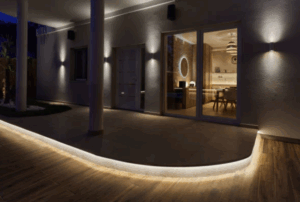
For Security Lighting
- LEDs provide better visibility, motion detection integration, and longer performance.

For Accent Lighting
- Halogens were once preferred for their warm color, but newer LEDs now offer the same warmth with better efficiency. And even more so for romantic lighting.

Ideal Uses for LED:
- Pathway lighting
- Uplighting for trees
- Pool and patio illumination
- Motion-activated security lighting
Ideal Uses for Halogen:
- Short-term event lighting
- Warm-toned accent areas (if lighting aesthetics trump energy savings)
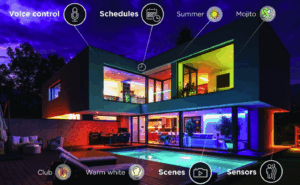
LED Lighting Costs in Austin
The initial cost of LED systems can be higher, but rebates and local incentives often help offset costs in Austin and other cities focused on energy conservation. Halogens are cheaper to buy upfront—maybe $5–$10 per bulb. But factor in replacements, higher energy bills, and maintenance, and they become a more expensive choice long-term. LEDs cost more initially (around $15–$30 per bulb), but their long lifespan and efficiency make them more cost-effective within 1–2 years.
Tip: Check with local energy providers like Austin Energy for possible rebates on LED upgrades.
What Texas Homeowners Are Choosing in 2025
Trends show that Texans are increasingly choosing LED for long-term reliability, energy efficiency, and the ability to integrate with smart home systems.
“We switched from halogen to LED with Sunscape last year, and our energy bill dropped immediately. Plus, the yard looks amazing!”
In most cases, LED is the superior option for Texas outdoor lighting. It’s cooler, smarter, and more cost-efficient. However, if you need temporary, warm-toned light for special occasions, halogen still has a role. Want help choosing the right lighting system for your yard? Contact the Sunscape team today.
See Also: Why Homeowners Trust Sunscape for Custom Outdoor Lighting in Austin
Longevity in Texas Weather
LEDs are built to last. With a lifespan of up to 50,000 hours, they outperform halogens that typically max out around 2,000–4,000 hours. LEDs also handle Texas heat better—they emit less heat and are more resistant to moisture and vibration. While, halogen lights are notorious for burning hot. In Texas summers, that means more strain and quicker burnout. Rain? Not their strong suit either.
Brightness & Color: The Visual Difference

Halogen lights are known for their warm, natural glow, a result of their incandescent roots. They produce a high lumens-to-watt ratio, meaning they offer decent brightness for their energy use. However, to achieve high brightness, halogens consume significantly more power. LEDs, on the other hand, are incredibly efficient. They produce more lumens per watt and maintain consistent brightness over time. You can get the same—if not more—illumination from an LED using 75–80% less energy. Plus, they don’t dim as quickly with age, giving you long-term lighting clarity.
Winner for brightness per watt: LED
Halogens emit a warm white light (usually around 2700K to 3000K), which mimics natural sunlight. It’s ideal for creating a cozy, inviting ambiance in patios, gardens, or entryways. LEDs are available in a wide spectrum of color temperatures, from warm (2700K) to cool white (5000K+). This means you can customize the mood of your outdoor space—whether you want soft, ambient lighting for entertaining or crisp, cool light for security and visibility. Modern LEDs even come with adjustable color temperature features or smart lighting controls, letting you shift the tone based on time of day or event.
Need flexibility? Go LED.
So, at the end of the day, what’s best for AUSTIN? In almost every category—efficiency, durability, lifespan, safety, and environmental impact—LEDs come out ahead. The only scenario where halogens still appeal is if you’re seeking a vintage, ultra-warm aesthetic. But even that’s replaceable now with smart LEDs.
Halogen to LED: How to Upgrade Without Redesigning Everything
Good news! You don’t have to rip up your entire outdoor lighting layout to switch to LED. Many modern LED systems are retrofit-compatible, meaning they can be swapped into existing halogen fixtures. Here are some tips to help you transition seamlessly;
- Match lumens, not watts
- Use compatible dimmers or smart controllers
- Consult a professional installer for large systems
The Impact of Lighting on Your Home’s Resale Value
Modern LED systems integrate easily with automation platforms like Alexa, Google Home, and dedicated outdoor lighting apps. You can:
- Adjust brightness levels by zone
- Schedule on/off cycles
- Integrate with motion sensors
Obviously, real estate agents across Texas agree: well-designed, energy-efficient lighting adds instant curb appeal. Buyers are increasingly drawn to homes with modern LED systems that offer security, style, and long-term savings.
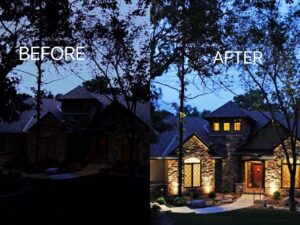
Read More: How Outdoor Lighting Increases Your Home’s Value in Austin’s Market
What Austin Homeowners Are Saying
We’ve heard from dozens of Austin homeowners who’ve made the switch. One homeowner from Barton Hills shared:
“Our electric bill dropped noticeably after we upgraded to LEDs—and the yard looks better than ever.”
Another in Lakeway said:
“I used to replace bulbs every few months. With LEDs, I haven’t touched them in over a year.”
Our Final Take: Light Smarter, Not Harder
In Texas, lighting isn’t just functional—it’s a form of expression, security, and value-building. it’s about choosing a solution that fits your lifestyle, your budget, and your environment. With Texas weather being as unpredictable as it is, durability, efficiency, and smart control matter more than ever. LED lighting delivers all of that and more, making it the clear choice over halogen. It’s time to stop choosing between beauty and performance—you can have both.
Contact Sunscape Outdoor Lighting for a lifestyle UPGRADE today!

